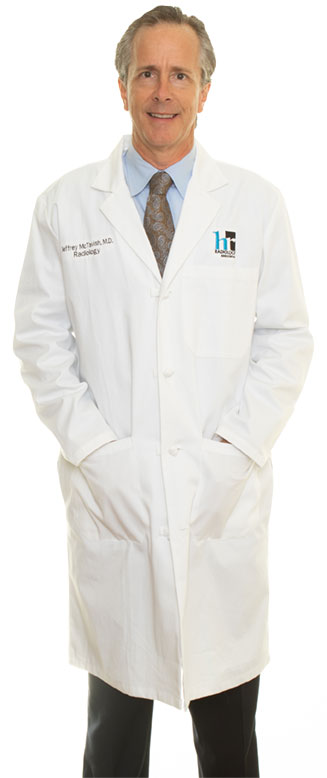President, Hampton Roads Radiology Associates
 As advanced imaging technology allows radiologists to find ever-smaller cancerous growths, Dr. Jeffrey McTavish also is thinking big.
As advanced imaging technology allows radiologists to find ever-smaller cancerous growths, Dr. Jeffrey McTavish also is thinking big.
Radiology shouldn’t end at reading scans and reporting suspicious growths, he feels. Instead, Dr. McTavish is leading a system-wide Sentara Healthcare effort to ensure that every patient who needs follow-up clinical action receives that care.
“We want to extend the reach of radiology in a really powerful way,” he says. “We plan to take more ownership in care after imaging, so not even a single patient falls through the cracks.”
The project is just one that Dr. McTavish has spearheaded this decade to improve patient care throughout the region. He was physician lead on Sentara’s drive to drastically shorten wait times between screening mammograms and tissue biopsies; is principal investigator on a push to identify malignant pulmonary nodules earlier; and is physician lead on an electronic decision support system to help physicians prescribe the correct radiology studies.
At Hampton Roads Radiology Associates, a large regional practice that services Sentara and Bon Secours hospitals, Dr. McTavish is a specialist in abdominal imaging – diagnosing ailments that historically might have required a scalpel.
“Modern CT and MRI allow us to accurately stage very small tumors and to avoid exploratory surgery in the vast majority of acute abdominal processes,” he says. “When I was in training, people had to hold their breath for up to 45 seconds for abdominal MRI. Today we can obtain much higher-quality images in as little as 5 seconds, which has opened the door to imaging practically everything in the abdomen.”
Magnetic Resonance Spectroscopy, which can identify biochemical markers in cancerous tissues, is an exciting advance in abdominal imaging, he adds: “Most of our imaging has been anatomic up to this point, but this gets us to the molecular level.”
Dr. McTavish grew up in a small town outside Toronto, where physicians were community role models. He decided on a medical career by high school, although he also was a gifted piano player and earned an associate degree in piano performance from Toronto’s Royal Conservatory of Music.
At the University of Toronto, Dr. McTavish completed a medical degree and residency in Diagnostic Radiology, followed by a fellowship in Body MRI at Harvard Medical School/Brigham and Women’s Hospital. He chose radiology due to rapid progress in imaging technology that have turned CT and MRI into the crucial diagnostic tools now taken for granted.
After three years as an Attending Radiologist at Brigham and Women’s and Harvard Medical School, Dr. McTavish moved to Hampton Roads in 2002 to work at Hampton Roads Radiology Associates. He has been President of the practice since 2009.
In 2014, Dr. McTavish worked with a team to help Sentara patients with suspicious mammogram findings spend fewer anxious days before diagnostic mammograms and biopsies. By 2016, thanks to better communication with radiologists, surgeons and referring physicians, the median wait had dropped from 16 days to 6, one of the best timetables in the country.
Dr. McTavish’s current passion is an effort to confirm closed loop communication in 100 percent of radiology results that require clinical action or imaging follow-up. Follow-up failures can occur for a variety of reasons, from technology glitches to physician retirements.
As an example, Dr. McTavish cites a patient with acute appendicitis whose scan shows a small pulmonary nodule as a secondary finding. A radiologist might advise a follow-up CT in six months. Yet quite often, that never happens due to the focus on the acute problem, especially if a patient hears – truthfully – that a growth is likely benign.
Dr. McTavish’s team is creating a virtual patient database with a three-step plan: sending a letter or email to the ordering physician, having a radiologist call that doctor directly, and mailing a registered letter to the patient. “We see hundreds of actionable findings across our system every day,” Dr. McTavish notes. “This would be a huge step forward.”
Simultaneously, Dr. McTavish is leading a grant project for the Eastern Virginia Medical School-Sentara Healthcare Analytics and Delivery Science Institute to identify barriers to follow-up compliance for small lung growths. This is important for improving survival rates, as lung malignancies in the region are identified at later stages than the national average.
On the front end of care, Dr. McTavish has helped implement an electronic tool that offers real-time feedback to medical providers as they order radiology studies. The system aims to ensure patients get the best scans – and nothing unnecessary – based on established guidance from the American College of Radiology.
“The computer will automatically send an alert if the imaging study isn’t a good match for a clinical problem,” Dr. McTavish explains. “It also will provide links to literature detailing the reasons why, along with better options.”
Finally, Dr. McTavish has served as chair and physician lead of Sentara’s Imaging High Performance Team, a collaborative initiative to standardize advanced reporting, radiation dose, technology assessment and patient experiences across 12 hospitals in Virginia, one in North Carolina, and eight radiology practices.
In his off-hours, Dr. McTavish enjoys spending time with his wife, Andrea, a fellow radiologist, and their three college-aged children. He likes playing ice hockey, skiing and hiking; last year, his family climbed Africa’s Mount Kilimanjaro.
In the future, Dr. McTavish expects radiology will become increasingly sub-specialized, making more experts available 24/7. Already, he considers the level of expertise in Hampton Roads to be on par with major teaching systems.
“We all push each other to work at the highest level,” he says. “We’re always ready to tackle the next new challenges in radiology.”

